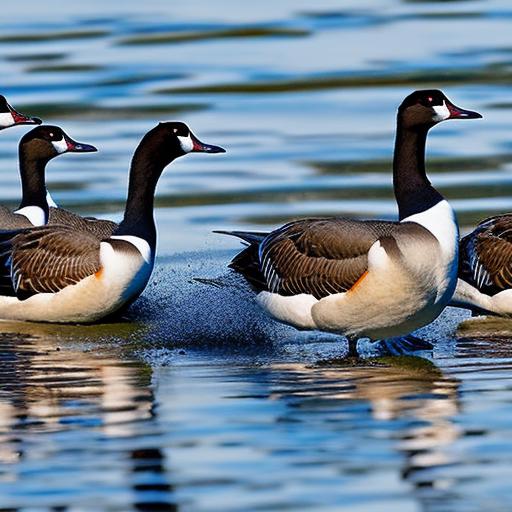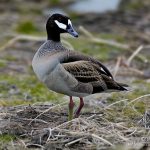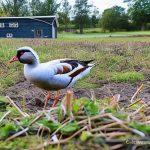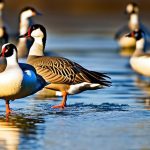Canadian geese have become a common sight in urban areas across Canada, and while they may be beautiful creatures, their presence can often cause problems. From damaging property to leaving behind droppings that can be a health hazard, finding humane solutions to manage the Canadian geese population is crucial. It is important to address this issue in a way that respects the well-being of both the geese and the communities they inhabit.
Key Takeaways
- Canadian geese are territorial and protective of their young, so avoid approaching them.
- Physical deterrents like fencing and netting can prevent geese from accessing certain areas.
- Visual deterrents like decoys and scarecrows can trick geese into thinking an area is unsafe.
- Creating a hostile environment by removing food sources and adding obstacles can discourage geese from staying.
- Exclusion barriers like hedges and shrubs can prevent geese from entering certain areas.
Understanding Canadian Geese Behavior
To effectively manage the Canadian geese population, it is essential to understand their behavior. Geese are attracted to certain areas because of the availability of food and water sources, as well as suitable nesting sites. They are herbivores and feed on grasses, grains, and aquatic plants. Geese also prefer open areas near water bodies where they can easily spot predators.
During nesting season, which typically occurs from March to June, geese are particularly protective of their nests and can become aggressive if they feel threatened. Understanding their nesting and feeding habits can help in implementing effective deterrent strategies.
Implementing Physical Deterrents
One approach to managing the Canadian geese population is through the use of physical deterrents. These barriers can be used to prevent geese from accessing certain areas, such as parks or golf courses. Examples of physical deterrents include fences, netting, and hazing techniques.
Fences can be effective in keeping geese out of specific areas, but they need to be tall enough to prevent the birds from flying over them. Netting can be used to cover bodies of water or vegetation that geese are attracted to, making it difficult for them to access these resources. Hazing techniques involve using loud noises or motion-activated devices to scare away geese.
While physical deterrents can be effective in managing the Canadian geese population, there are some drawbacks to consider. Fences and netting may not be aesthetically pleasing and can be costly to install and maintain. Hazing techniques may also be temporary solutions, as geese can become habituated to the noise or devices over time.
Utilizing Visual Deterrents
Visual deterrents can also be effective in managing the Canadian geese population. These deterrents work by creating an environment that is unappealing or threatening to geese, causing them to seek out alternative locations. Examples of visual deterrents include scarecrows, reflective tape, and predator decoys.
Scarecrows can be placed in areas where geese are likely to gather, creating a visual deterrent that mimics a potential threat. Reflective tape can be hung from trees or poles, creating a visual disturbance that can deter geese from landing or nesting in the area. Predator decoys, such as plastic owls or coyotes, can also be effective in scaring away geese.
Visual deterrents are often cost-effective and easy to implement. However, they may not be as effective in the long term, as geese can become accustomed to their presence over time. It is important to regularly move or change the visual deterrents to maintain their effectiveness.
Creating a Hostile Environment
Creating a hostile environment for Canadian geese is another approach to managing their population. By making an area less attractive to geese, they are more likely to seek out alternative locations. There are several ways to create a hostile environment for geese.
One method is to remove or reduce food sources that attract geese. This can involve regularly mowing grassy areas to make them less appealing for grazing, or using landscaping techniques that discourage geese from feeding on vegetation. It is also important to properly dispose of garbage and food waste, as these can attract geese.
Another method is to modify the landscape to make it less suitable for nesting. This can involve planting tall grasses or shrubs that make it difficult for geese to access nesting sites. Creating barriers, such as rocks or gravel, around bodies of water can also discourage geese from nesting in these areas.
Establishing Exclusion Barriers
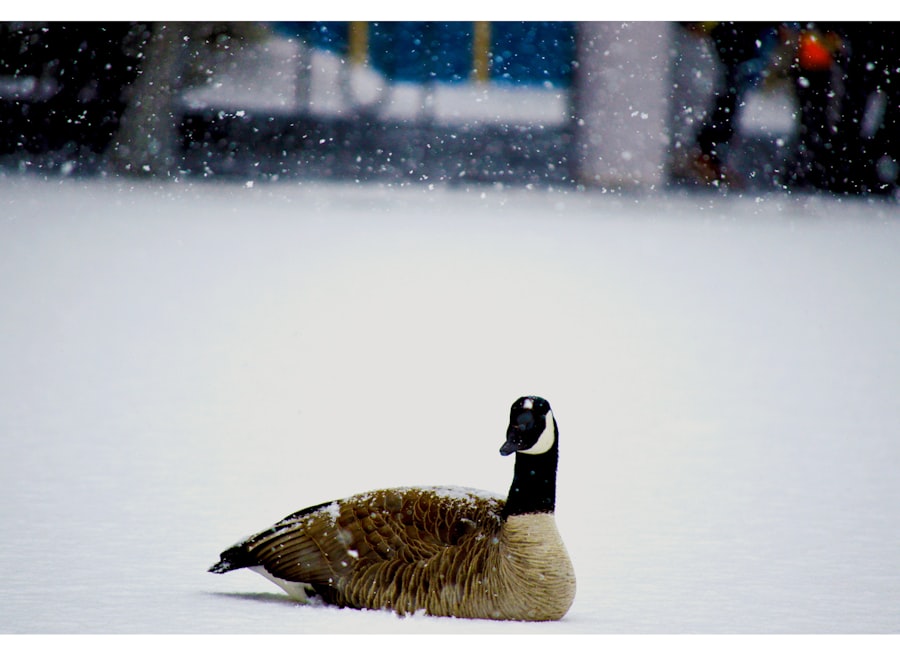
Exclusion barriers can be an effective way to manage the Canadian geese population. These barriers physically prevent geese from accessing certain areas, such as ponds or lawns. Examples of exclusion barriers include floating barriers, goose fences, and grid systems.
Floating barriers are placed on bodies of water to create a physical barrier that prevents geese from landing or swimming in the area. Goose fences are low fences that can be installed around lawns or other areas to prevent geese from accessing them. Grid systems consist of a series of wires or ropes that are spaced closely together, making it difficult for geese to land or walk on them.
Exclusion barriers can be effective in managing the Canadian geese population, but they may require regular maintenance to ensure their effectiveness. Geese may attempt to find ways around the barriers, so it is important to regularly inspect and repair any damage.
Using Sound Deterrents
Sound deterrents can be an effective way to manage the Canadian geese population. These deterrents work by emitting loud noises or sounds that are unpleasant or threatening to geese, causing them to seek out alternative locations. Examples of sound deterrents include propane cannons, sonic devices, and recorded distress calls.
Propane cannons produce loud bangs at regular intervals, mimicking the sound of a gunshot and scaring away geese. Sonic devices emit high-frequency sounds that are unpleasant to geese but not harmful to humans or other animals. Recorded distress calls can be played to mimic the sound of a distressed goose, causing other geese to become alarmed and leave the area.
Sound deterrents can be effective in managing the Canadian geese population, but they may also disturb nearby residents or wildlife. It is important to consider the potential impact on the surrounding environment before implementing sound deterrents.
Implementing Taste Deterrents
Taste deterrents can be an effective way to manage the Canadian geese population. These deterrents work by making food sources unappealing or unpleasant to geese, causing them to seek out alternative locations. Examples of taste deterrents include chemical repellents and natural substances.
Chemical repellents can be sprayed on grass or vegetation to make it taste unpleasant to geese. These repellents are typically safe for humans and other animals but should be used according to the manufacturer’s instructions. Natural substances, such as hot pepper spray or garlic oil, can also be effective in deterring geese from feeding on certain areas.
Taste deterrents can be effective in managing the Canadian geese population, but they may need to be reapplied regularly to maintain their effectiveness. It is important to use taste deterrents responsibly and avoid using harmful chemicals that could pose a risk to humans or other animals.
Employing Professional Services
In some cases, it may be necessary to call in professional help to manage the Canadian geese population. Professional services can provide expertise and specialized equipment to effectively deter geese from certain areas. Examples of services offered by professionals include habitat modification, egg addling, and relocation.
Habitat modification involves making changes to the landscape or environment to make it less attractive or suitable for geese. This can include planting certain vegetation, installing exclusion barriers, or modifying water bodies.
Egg addling is a method of population control that involves shaking or coating goose eggs with oil to prevent them from hatching. This method is typically used in conjunction with other deterrent strategies and requires a permit from the appropriate authorities.
Relocation involves capturing and relocating geese to alternative locations where they are less likely to cause problems. This method should only be used as a last resort and should be carried out by professionals who have the necessary permits and expertise.
Maintaining a Clean Environment
Maintaining a clean environment is important in managing the Canadian geese population. Geese are attracted to areas with abundant food sources, so it is important to properly dispose of garbage and food waste. Regularly cleaning up areas where geese gather, such as parks or golf courses, can also help to discourage their presence.
It is also important to regularly remove goose droppings from public areas. Goose droppings can contain bacteria and parasites that can be harmful to humans and other animals. Regular cleaning and disinfection can help to reduce the risk of disease transmission.
Respecting Regulations and Laws
When managing the Canadian geese population, it is important to respect regulations and laws regarding geese. In Canada, geese are protected under the Migratory Birds Convention Act, which prohibits the harming or disturbing of migratory birds, including Canadian geese, without a permit.
It is important to familiarize yourself with the regulations and laws in your area before implementing any deterrent strategies. If you are unsure about the legality of a particular method or action, it is best to consult with local authorities or seek professional advice.
Managing the Canadian geese population in urban areas requires a humane approach that respects the well-being of both the geese and the communities they inhabit. By understanding their behavior and implementing effective deterrent strategies, it is possible to reduce conflicts and create a harmonious coexistence.
Physical deterrents, visual deterrents, creating a hostile environment, establishing exclusion barriers, using sound deterrents, implementing taste deterrents, employing professional services, maintaining a clean environment, and respecting regulations and laws are all viable options for managing the Canadian geese population.
Taking action and making a difference starts with individuals and communities coming together to find humane solutions. By implementing these strategies and working together, we can create a safer and more enjoyable environment for both humans and Canadian geese.
If you’re looking for effective ways to keep Canadian geese away from your property, you might find this article on poultrywizard.com helpful. It provides valuable insights and tips on how to deter these birds from causing damage and leaving behind unwanted droppings. From installing fencing and using decoys to implementing landscaping techniques, this article offers practical solutions to keep your space goose-free. Check it out here for more information.
FAQs
What are Canadian geese?
Canadian geese, also known as Canada geese, are large waterfowl native to North America. They are known for their distinctive black heads and necks, white cheeks, and brown bodies.
Why do Canadian geese become a nuisance?
Canadian geese can become a nuisance when they gather in large numbers, causing damage to property, leaving droppings everywhere, and becoming aggressive towards humans.
What are some methods to keep Canadian geese at bay?
Some effective methods to keep Canadian geese away include using visual deterrents like scarecrows or reflective tape, installing physical barriers like fences or netting, using noise deterrents like propane cannons, and employing trained dogs to chase the geese away.
Is it legal to harm Canadian geese?
Canadian geese are protected under the Migratory Bird Treaty Act, which makes it illegal to harm, harass, or kill them without a permit. It is important to use humane and non-lethal methods to deter Canadian geese.
How can I prevent Canadian geese from nesting on my property?
To prevent Canadian geese from nesting on your property, you can use deterrents like visual scare tactics, physical barriers, or habitat modification. It is important to start early in the season before the geese have a chance to establish a nesting site.
Meet Walter, the feathered-friend fanatic of Florida! Nestled in the sunshine state, Walter struts through life with his feathered companions, clucking his way to happiness. With a coop that’s fancier than a five-star hotel, he’s the Don Juan of the chicken world. When he’s not teaching his hens to do the cha-cha, you’ll find him in a heated debate with his prized rooster, Sir Clucks-a-Lot. Walter’s poultry passion is no yolk; he’s the sunny-side-up guy you never knew you needed in your flock of friends!

